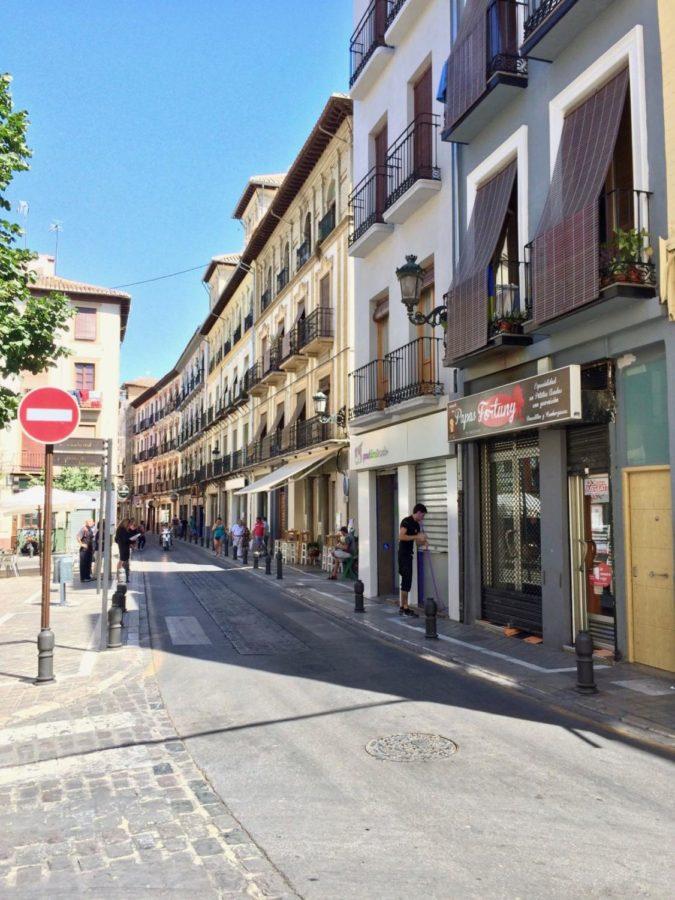A Guide to Tapas and Late-Night Food in Granada
January 1, 2017
Granada is, irrefutably, a student’s city. Universidad de Granada (UGR) draws more European erasmus students than any other university in the EU, and students make up about a fifth of the city’s population. Combine that with Granada’s beauty, varied architecture, and rich history, and there’s no reason to wonder why so many American students study abroad there. The time students spend studying abroad in Andalucía (the southern region of Spain in which Granada sits) often easily becomes the highlight of their college years, especially for those who love late nights. If you’re eager to try croquetas and stay out all night, read on.
Night life starts late in Spain. Dinner is often at 8 or 9 PM, and on most nights (or every night in the summer) tapas bars start to fill around 10 PM or later. Do NOT, under any circumstance, try to go to a club before 1:30 AM. The awkward time in between dinner and dancing is when everyone goes to tapas bars.
Granada is one of the only cities in Spain left that does real tapas. No, any tapas you found in Madrid were not tapas–if the food isn’t free with your drink, it doesn’t count in my book, and if they just fed you olives and nuts, I hope you flipped the table in protest. Tapas is such a major part of Granada’s atmosphere that immigrants even adapt their cuisines to tapas culture. For example, in Plaza Albert Einstein (which has half a dozen tapas bars to choose from) near UGR’s science campus, there’s a Chinese tapas bar Restaurante Chino la Paz, serving tiny portions of fried rice and cashew chicken alongside tinto de verano.
For a more classic tapas experience, I recommend going to Calle Pedro Antonio de Alarcón. With options ranging from classic Spanish to Mexican to Argentinian tapas bars, this street and its adjacent alleys and plazas are the epicenter of 10 PM-1 AM nightlife in Granada. For tapas at a low price, I recommend the trendy and tasty Charlotte, which serves mainly Mexican-inspired tapas. For something more low-key, try one of the outdoor bars in nearby Plaza de Gracia or the tapas bar Parrilla Argentina (though most menu items at Parrilla Argentina include pork, so beware if you have dietary restrictions). Pedro Antonio is filled to the brim with tapas bars. You will have no problem finding one that catches your eye.
Pedro Antonio is also, however, packed with bars. This isn’t necessarily a bad thing, but beware that the bars do not serve much food and are often gimmicky and targeted at tourists. For example, Pub Wall Street, where the prices of certain drinks go up and down like “stocks,” and Chupiteria69, a bar that serves only shots and gives you tickets to collect and later trade in for prizes like it’s Chuck E. Cheese, often draw in exclusively American student crowds. Join them if you want, but don’t walk in expecting a tapas bar.
Likewise, shops you see with the words Döner, Kebab, or Pollo in the name are gyros places, not tapas bars. There are gyros places all over Granada, but especially on Pedro Antonio. Honestly, though, the unique Moroccan-Andalusian creation of the “gyro completo” (which adds a fried egg to your classic gyro) is so delicious, I wouldn’t begrudge you for skipping tapas to eat it. My favorite was Shawarma Damasco. On most nights, these places are open way late, and are usually students’ morning meal on the way out from nightclubs at 5 AM.
Finally, the local picks. Some locals complain that places on Pedro Antonio serve low-quality, greasy foods, and instead recommend delving into the alleys branching off from Calle Recogidas. There, you’ll find unique and quality places like Bar Poë and Oumkalsum. Bar Poë is a Brazilian tapas bar patronized by older crowds, though it is no less lively or packed than the college kids’ haunts. Omkalsum is a highly-rated Moroccan tapas bar, named after the revered Egyptian singer Umm Kalsum. Omkalsum, and Arab tapas bars like it, are an important and vital exhibition of true Granadan culture. Granada commercializes itself for tourists by capitalizing on Moroccan culture and the history of the Muslim Spanish kingdoms of Granada’s past. However, as Spaniards make money selling Moroccan souvenirs to American tourists, actual Moroccans and Muslims are derided and often discriminated against all over the country. Arabs and Muslims shaped much of Granada’s culture in the past, and modern Moroccan immigrants in Spain are part of Granada’s economic and cultural foundation. For that reason, I recommend supporting Moroccan-owned businesses like Omkalsum and appreciating Arab-Spanish fusions in culture and food during your time in Granada.
Now, all those mojitos and nachos and gyros should keep you busy until after midnight. For what to do after tapas and before crawling blurry-eyed to your morning classes, wait for my article on Granada’s nightclubs.






























































































































































